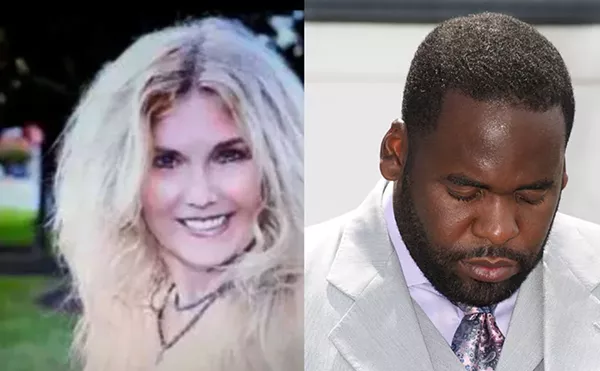
Audio By Carbonatix
[
{
"name": "GPT - Leaderboard - Inline - Content",
"component": "35519556",
"insertPoint": "5th",
"startingPoint": "3",
"requiredCountToDisplay": "3",
"maxInsertions": 100,
"adList": [
{
"adPreset": "LeaderboardInline"
}
]
}
]
Throughout the continent, many Africans believe that the head is where wisdom is housed, and is also the entrance and exit point of the spirits. Therefore, the head is afforded special attention. The hair is adorned directly — or the cranium is crowned with elaborate headdresses constructed of matter possessing the power to bridge the divide between the worlds of the material and nonmaterial, the concrete and the abstract, the secular and the spiritual.
These elements of adornment likely consist of things the particular cultures deem precious and powerful: seeds or stones, animal or avian products, flowers or plants or pigments derived from them. This paraphernalia serves as indicator of status or rank, and further endows the head with specific powers according to the needs of the culture and its creation. The importance of the head and its means of adornment is universal throughout the African diaspora.
Crowns examines that cultural carry-over as it manifests itself among a group of contemporary African-American women, primarily in Winston-Salem, N.C. It is dedicated by its authors in part to “our favorite hat queens.” The book consists of photographs of these queens in their church hats. It is accompanied by the women’s essays explaining the role church hats have played and continue to play in their lives. They are the bearers of the tradition of headwear being more than mere accouterment, accessory or fashion appendage. Each of the hats depicted is a statement; an attitude steeped in a tradition of strength.
These photographs bring to mind the fading black-and-white or sepia snapshots in the photo albums, on mantels or piano tops of African-American homes. Time-distant mothers, grandmothers, aunts and other female relatives are often less fascinating for their blood connections than for the sense of audacity and style among those ladies who did their day-to-day in the awful system of segregation that served as a context for too many of the stories told in seriousness or humor about them.
They stand straight and sassy, against rural backgrounds, smiling into the oppressive Southern sunshine. A stance that continues down through the years as the backgrounds changed to Northern brick houses and the latest automobiles. In these family testaments, their finery is inevitably topped by hats as flattering as a lover’s smile. The hats are like totems, milestones of our sundry diasporic migrations. They are defiant as clenched fists.
(As a sidebar, the men in their fedoras in these family pictures were no slouches either.)
In that tradition, the women depicted in Crowns would no more consider attending Sunday service without their church hats than they would without their souls. This headgear serves as symbol and definer, and is a celebration of the occasion of worshiping their Lord and savior. But each is also intended as a conversation piece. It is meant to be commented on. To the African-American woman, it is not simply that you have a hat on, or possess a wardrobe of them, but that you are wearing it. Making it work. Stating that by your choice and presentation of it you are transforming mere material into a visual and cultural experience. Theater. A one-woman performance with a hat that is saying something.
And its tongue, coated in history and honey, offers a soliloquy not only on its wearer’s station and prominence, but serves as a visual point of contact between taste and tradition. Hats are outward manifestations of the inner sprit and its need to praise and be praised. A church hat is, by the act of its donning, a chance to transcend, to sartorially or spiritually be born again, and to receive anew, with each new coming, the possibilities and the hosannas of the occasion. It is a deep sign, a signifier which vibrates unbroken back, if not to the first, at least close to the bearer’s ancestral beginning. It also testifies to the endurance of the brutal and inhumane conditions of African-American women’s lot in America. The church hat’s wearer is no longer just herself but is an intermediary between the ages and levels of faith and fortitude. She is at once a witness and a participant in the ceremony.
But the tricky part is that one must always remain ladylike and remember that she is to look her best, lighted by her inner glow and be a refection of her savior, not the source of the light that attracts undeserved personal praise. Her hat should not cross the line into the outlandish. It should not be a Rube Goldberg-like view-blocker, more attractive to Satan than to the Lord.
It can be made of bows and flowers, mink or satin, have brims stingy or broad, silk leaves, sequins, semiprecious stones, be of various furs in various colors, feature curled ribbons, polka dots, netting, lace, gossamer or metallic materials of many kinds. It should be one of a kind and a magnet for sincere compliments, but not become, because of its design or the way it is tilted, inspiration for envy or talking out of the side of the mouth.
The women pictured here are as varied as their hats. There are those with titled positions, from adjunct law professor, student and lab technician, to receptionist, boutique owner and evangelist, to child-care provider and customer-service coordinator. Their ages range from 22 through 78, with assorted “45-ish,” “60-something” and “a lady never tells her age” sprinkled throughout.
Each of their accompanying personal essays is wonderfully succinct and insightful. They evoke memories of Jim Crow stores that refused either admittance or the privilege of trying hats on inside. There are tales of and inheritance from a mother whose hat helps to bridge a term of estrangement, stories of struggles with grades of hair and color consciousness, lay-away plans, funeral-home fans and the wonder of a basement full of hats willed to a young admirer.
If there’s a complaint, it’s that Crowns errs on the side of the conservative. The photographs, Michael Cunningham the photographer tells us in his photographer’s note, were shot in black-and-white in order to be “artistic,” and so as not to overshadow the women. This shows a definite lack of faith in the strength of his human subjects. Photographing in black-and-white is equivalent to recording the blues in mono, or reissuing them with scratches intact to make the sound more authentic.
Duke Ellington, who knew a thing or two about style and women, had a fondness for saying, when flirting with a woman in a hat, “You really make that hat look good.” Even in black-and-white, the ladies in Crowns do just that, and vice versa. I just miss the joyful noise that the addition of color would have made in this otherwise exciting and insightful book.
Craig Marberry will sign copies of Crowns this Sunday, 2-4 p.m., following church services, at Borders Books Music & Café, 5601 Mercury Dr., Dearborn.
For a local slant on this topic, read our 8/15/00 story "On top of it all," about Detroit City Council member Kay Everett. For Everett, hats are more than fashion — they’re good friends.
Playwright and poet Bill Harris writes about books for the Metro Times. E-mail him at letters@metrotimes.com.





